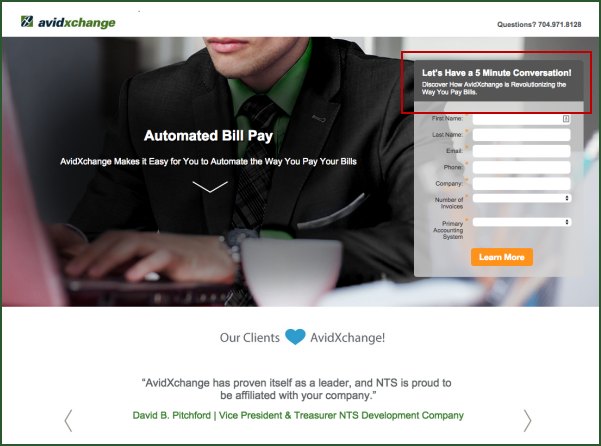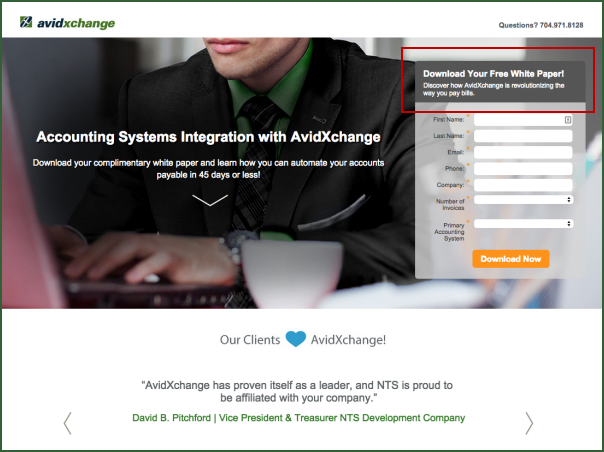by
David Kirkpatrick, Reporter
THE CUSTOMER
AvidXchange is a SaaS (software as a service) company providing a solution for invoice and payment automation. This space has solutions for small companies as well as solutions tailored for larger, enterprise-level companies. To meet that gap in the middle, AvidXchange targets mid-market companies.
According to Jen Ittenbach, Marketing Communications Manager, AvidXchange, "[In] the mid-market, there just wasn't really a lot available. Solutions that are out there for large companies are cost-prohibitive, so AvidXchange really found this nice niche of mid-sized companies that definitely had paper problems and a lot of menial tasks associated to them, but there just wasn't a solution available."
The company originally went after the real estate and banking markets, but it has since branched out into other industries. In its marketing, the team's targets include CFOs, controllers and accounts payable managers.
CHALLENGE
Ittenbach explained that AvidXchange had been doing a good job with its internal marketing program with tactics such as hosting webinars and attending trade shows, but it struggled with lead generation via paid search.
The team was small — only three people — and Ittenbach felt she just didn't have the time to manage PPC advertising while also handling all her other roles and responsibilities.
It was determined the solution would be to bring a third-party provider into paid search at AvidXchange, but the actual goal was to gain key insights from paid search that could be applied to other marketing efforts, particularly search engine optimization and landing pages.
CAMPAIGN
Paid search was an important marketing channel at AvidXchange, and the team wanted to optimize its PPC program and its overall marketing performance across multiple channels.
In finding a vendor to help execute the effort, AvidXchange looked for a company with B2B experience. One drawback the team found in an earlier vendor was more experience in consumer marketing than B2B, and, as Ittenbach explained, "it's a slightly different game in knowing how to target the right people."
"The key differentiators for us when it came to [the vendor] was No. 1, their experience with B2B, but No. 2 [was] the fact that they could kind of manage the entire conversion process," she said, adding that, "[They would] have the ability to update the landing pages and help us to optimize them along the way, and that was something that a lot of companies only offered on the SEO and PPC side of things. They just didn't offer the landing page support to go along with it."
This case study focuses on how that campaign impacted landing pages and content strategy at AvidXchange as well as how it led to testing and optimization on the company's digital marketing.
Step #1. Identify problems with current landing pages
The key issue tying the then-current landing pages with paid search was reaching the correct audience. The team found that searches related to accounts payable topics tended to drive consumer-related traffic rather than B2B traffic. With this issue in mind, the first step in revamping the landing pages at AvidXchange was making sure conversions on those pages were the B2B target audience.
The solution was to make those pages much more B2B-specific to dissuade B2C visitors from filling out a lead generation form and essentially adding a fundamentally unqualified lead to the pipeline.
This was accomplished with what the team describes as "B2B imagery" — mainly in the form of stock photo of a businessman at a computer that is manipulated to match AvidXchange's branding — and language that appealed to B2B visitors while, at the same time, conveying to B2C visitors that they were at the wrong website to meet their needs.
Ittenbach also mentioned, "One of the things with [the vendor] really helping to manage the landing page process for us was really being able to align the ad copy itself with the landing page copy and being able to update that on a regular basis."
Step #2. Learn what drives landing page conversions
One early split test on AvidXchange's landing pages was comparing two very different calls-to-action once paid search visitors hit the pages.
The original call-to-action was simply an
invitation for a five-minute conversation. It wasn't for an open-ended invitation for a sales person to sell the visitor but a time-limited introduction to AvidXchange and its offering.

Click here to see the full version of this creative sample
The new call-to-action was an
inviatation to download a content piece — specifically a white paper — in exchange for the registration.

Click here to see the full version of this creative sample
Ittenbach said the idea behind the white paper incentive was that if someone visited the landing page from an accounts payable search, it was likely they had done some research and were possibly further down the sales funnel and could be ready to convert.
She added the team was also looking for quick wins with the PPC campaigns to prove ROI for paid search and be able to justify increasing that marketing budget line. At the same time, the team knew its typical sales cycle was 90 to 120 days.
On the sales cycle length, Ittenbach said, "It's because they have to get buy-in from so many people within the organization, and usually the person doing the research isn't the person that has enough clout to make the decision, so then they have to sell it up within their organization."
As it turned out in this case, the call-to-action for the five-minute conversation was something of a surprise winner to the team, and they also learned that landing pages were best for organically growing the database rather than immediate sales.
The landing page conversion ended up being an early-stage registration of a new prospect instead of a conversion further down the pipeline.
Step #3. Test additional elements of the landing pages
Testing the five-minute conversation versus a white paper download call-to-action was the initial test performed on AvidXchanges landing pages. After that test was complete, a plan was implemented where the team would perform one test each month on the pages that would end up with 98 to 99% significance.
Another early test after learning that the five-minute conversation drove a higher conversion rate was the messaging around "selling" the conversation, such as finding the most approachable language for the landing page. The key to this messaging was making sure the visitor understood that the exchange of a registration for the conversation was really simply an initial quick conversation and not a means to get them on the phone for a forced, one-hour demo right off the bat.
A more recent test has been utilizing video on the landing pages because data the team has uncovered suggested that video drove conversions.
An important element of the A/B testing and optimization program is a systematic approach of one test per month as well as using previous results or marketing research to drive future tests.
Step #4. Allow discoveries from PPC ads performance to influence landing pages
In paid search, and lead generation in general, at AvidXchange, "accounts payable automation" and "A/P automation" are important keywords the team described as "relatively competitive terms."
Using that knowledge from paid search led to creating landing pages customized for that area of search, improving the quality score of the PPC efforts, which in turn created a net savings in the cost-per-click for those campaigns.
At the point the entire PPC campaign from keywords targeted to the ad to clickthrough landing page's messaging and aesthetics were aligned.
Step #5. Facilitate communication between teams
The AvidXchange team and its vendor team had a reporting meeting every two weeks, conducted either in the AvidXchange office or virtually.
These meetings involved reporting paid search and landing page metrics as well as results of the current landing page test as soon as those results were relevant.
Reporting the test results was an important part of these meetings because those results were used to inform future tests.
For example, once it was found the five-minute conversation beat the white paper download for landing page conversion, the next test was the five-minute conversation pitted against a pop-up chat window on the landing page itself.
Step #6. Utilize testimonials on landing pages
The team described the overall paid search and landing page methodology as Venn diagram with three bubbles where the intersection would provide the most motivation for the target audience. Those three bubbles were:
- The ad has to be discoverable
- The communication has to be credible
- It has to be available when someone is interested in converting
The idea was continued in seeing the credibility aspect that "a lot of brand conversations get lost in a lot of direct response mediums," Ittenbach said.
The team saw a way around this in providing credibility with testimonials from the target audiences' peers — such as people in the real estate industry — explaining they are already effectively using AvidXchange's product. The team believed this would help set the company off from other paid search campaigns.
RESULTS
The one key result from this campaign was a 79% decrease in cost-per-lead.
However, beyond the result metrics, the team also uncovered interesting insights into its customers, such as the surprising result that a five-minute conversation beat a white paper download for converting on a landing page and that "talking to a salesperson was not evil," Ittenbach said.
Ittenbach added this effort also achieved the goal of providing insights, which could be applied across AvidXchange's marketing.
"We've used the best practices for landing pages for email campaigns. We've also used them for landing pages for webinars. We've really made sure that everything is really symbiotic and working together," she said.
Ittenbach added AvidXchange's next major marketing initiative is implementing a new marketing automation platform as well as taking a more inbound approach to its marketing strategy. She said the success with paid search served as a catalyst for realizing inbound was going to be a viable approach.
Creative samples
- Five-minute conversation call-to-action
- White paper download call-to-action
Sources
AvidXchangeMethod Savvy — AvidXchange's search and optimization vendor
Related Resources
Email Measurement: How a former Email Summit attendee achieved a 270% increase in conversionA/B Testing: How a landing page test yielded a 6% increase in leadsLanding Page Optimization: How to start optimization testing and get executive supportLanding Page Testing and Optimization: How Intuit grew revenue per visitor 23%Landing Page Optimization: How a navigation test increased leads 34%











